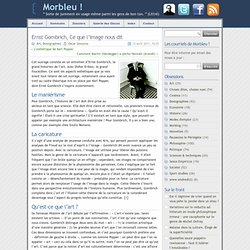

Ernst Gombrich, Ce que l’image nous dit. Cet ouvrage consiste en un entretien d’Ernst Gombrich, le grand historien de l’art, avec Didier Eribon, le grand foucaldien. Ce sont les aspects esthétiques que je vais avant tout retenir de cet ouvrage, notamment ceux ayant trait au cadre théorique mis en place par Karl Popper, dont Ernst Gombrich s’inspire ouvertement. Le maniérisme Pour Gombrich, l’histoire de l’art doit être prise au sérieux en tant que science. Elle doit être claire et rationnelle. Les premiers travaux de Gombrich porte sur le « maniérisme ». La caricature Il s’agit d’une analyse de jeunesse conduite avec Kris, qui pensait pouvoir appliquer les analyses de Freud sur le mot d’esprit à l’image − Gombrich dit avoir nuancé un peu sa position depuis. Qu’est-ce que l’art ? Sa fameuse débute par l’affirmation : « L’art n’existe pas.
La tradition Il y a une « écologie de l’image » qui désigne le contexte social dans lequel les œuvres sont créées, mais qui ne se limite pas à lui seul. L’intention Le style. Ernst Gombrich, Ce que l’image nous dit. Cet ouvrage consiste en un entretien d’Ernst Gombrich, le grand historien de l’art, avec Didier Eribon, le grand foucaldien.

Ce sont les aspects esthétiques que je vais avant tout retenir de cet ouvrage, notamment ceux ayant trait au cadre théorique mis en place par Karl Popper, dont Ernst Gombrich s’inspire ouvertement. Le maniérisme Pour Gombrich, l’histoire de l’art doit être prise au sérieux en tant que science. Elle doit être claire et rationnelle. Les premiers travaux de Gombrich porte sur le « maniérisme ». La caricature Il s’agit d’une analyse de jeunesse conduite avec Kris, qui pensait pouvoir appliquer les analyses de Freud sur le mot d’esprit à l’image − Gombrich dit avoir nuancé un peu sa position depuis.
Qu’est-ce que l’art ? Sa fameuse Histoire de l’art débute par l’affirmation : « L’art n’existe pas. La tradition Il y a une « écologie de l’image » qui désigne le contexte social dans lequel les œuvres sont créées, mais qui ne se limite pas à lui seul. RT @begonyacayuela - The Gombrich Archive: Enjoy! gombrich.co.uk // mthx for ... The Gombrich Archive. Creative Cartography: Mapping the Invisible City. Creative Cartography: Mapping the Invisible City - Maria Popova - Life. A book examines architects, designers, and other thinkers who have figured out how to visualize the urban experience Cities, maps and data visualization are frequent obsessions of mine, and the intersection of the three hits a sweet spot of the finest kind.

But how did urbanism, cartography, and information visualization first come together, and where are they going as bedfellows? That's exactly what Nadia Amoroso explores in The Exposed City: Mapping the Urban Invisibles -- an ambitious study of the invisible elements of the city, from demographics to traffic patterns to crime rate to environment, through "map-landscapes. " "It's Man's Ability to Perceive, it's the MAP. It's also the map through time with the ease of quick time and computer graphics and morphing, changing one pattern with another.
(Sound familiar?) This month, Amoroso launched DataAppeal, a web-based visualization tool for creating 3D and 4D data maps and animations, based on concepts from The Exposed City. Geschichte des grotesk-komischen : ein Beitrag ...